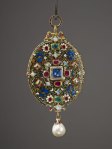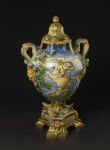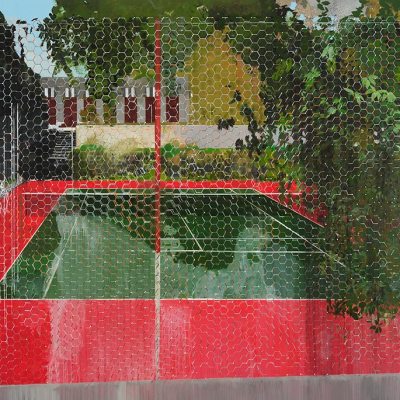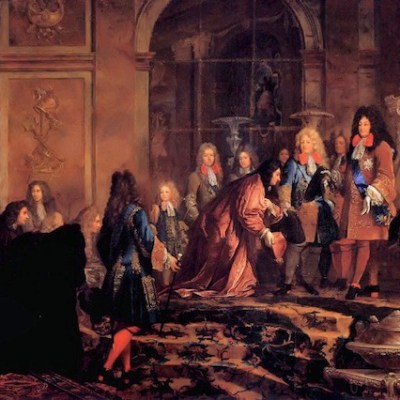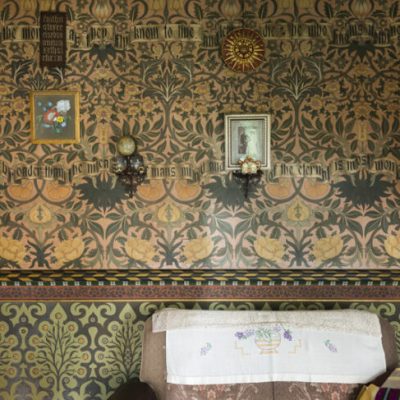From the May issue of Apollo: preview and subscribe here
The Waddesdon Bequest goes back on display at the British Museum next month in a newly restored gallery. This remarkable collection, left to the museum by Ferdinand de Rothschild, epitomises what private collectors have historically brought to public institutions
When Baron Ferdinand de Rothschild (1839–98) bequeathed his Waddesdon treasures to the British Museum in 1898, he made a clear stipulation. The collection was to be displayed ‘in a room separate and apart from the other contents of the Museum’. Likewise, Sir Arthur Gilbert’s gift to the British nation is housed at the V&A in its own separate galleries; Lady Wallace required that the Wallace Collection never be loaned, deaccessioned or added to; Albert Barnes set out exactly how his artworks should be displayed in Philadelphia; and William Burrell’s will has recently been controversially overturned to allow his collection of paintings and artefacts to tour overseas. Collectors like to leave their mark on their things.
Think, likewise, of all the publicly accessible collections still named after their original collector. Besides Wallace, Barnes and Burrell we have the John Soane, the Fitzwilliam, the Ashmolean, the Frick, the Getty, the Thyssen-Bornemisza, Guggenheims in Venice and New York, and the Isabella Stewart Gardner – to name but a few. In all of these, the founding collector remains eponymous and, to a greater or lesser degree, present in displays that range from entire domestic spaces to small monuments. Yet, we also have the Tate – now four Tates. How many visitors to Tate Modern on a Friday night make the connection to the Tate & Lyle sugar that they put in their tea, or to Henry Tate, the 19th-century sugar merchant who made possible the first gallery devoted to British art? ‘Tate’ now denotes a museum brand, not a founding collector.
Ferdinand de Rothschild (1839–98) with the dog Poupon in The Baron’s Room at Waddesdon Manor, Buckinghamshire. Photo: Waddesdon, The Rothschild Collection (The National Trust)
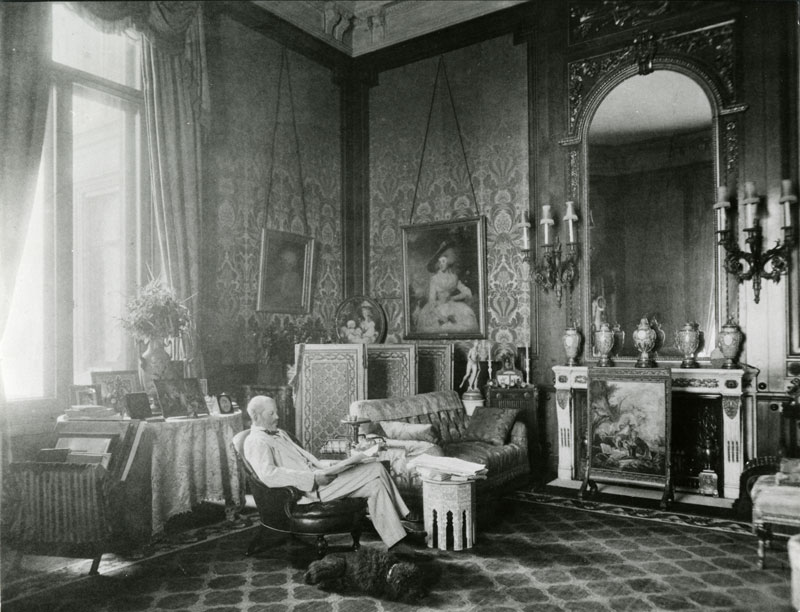
What, then, of the Waddesdon Bequest? The 265 pieces given by Ferdinand de Rothschild to the British Museum return on display next month in a beautifully restored space on the museum’s south front. It completes an axis of galleries that combine a commitment to celebrating the museum building’s historic design by Robert Smirke with an increasingly fashionable interest in the history of its collections and the people behind them. From the Enlightenment Gallery, which considers the 18th-century ideas that contributed to the formation of the museum – with its founder Sir Hans Sloane taking centre stage – you progress into Collecting the World, a room that highlights other donors and curators who have shaped the museum’s collections. But the likes of Sarah Sophia Banks and Augustus Wollaston Franks must now be looking on in green-eyed envy at Ferdinand de Rothschild.
Ferdinand’s collection is the only bequest ever to have been kept separate from other collections at the British Museum, and displayed as a discrete and named unit. His choice to call it the ‘Waddesdon Bequest’ links the objects permanently to his celebrated house in Buckinghamshire, Waddesdon Manor (now owned by the National Trust) and to its broader collections. The gift embodied his concern for public access to the arts, while its name recalled the mode of private sociability around exquisite objects for which Waddesdon was famous. There the great and the good of late 19th-century British and European politics and culture assembled in Ferdinand’s carefully crafted rooms, informally righting the world’s wrongs.
The extraordinary neo-Renaissance French château that Ferdinand created from scratch in the British countryside was largely filled with the fine and decorative arts of 18th-century Europe. They were assembled according to his unique taste, to create a rich but comfortable home within which to entertain, the objects subordinate to the social functions of their surroundings. His New Smoking Room, completed in 1896 in the Bachelor’s Wing, was therefore in marked contrast. It was shaped entirely around what Ferdinand called his ‘Renaissance Museum’, combining the finest of ‘plate enamels, Bijouterie, carvings in box wood, majolica, glass, arms and armour’ to recreate a 19th-century version of the princely Kunstkammer. This would become the Waddesdon Bequest, within which the glittering, exquisite objects acted as talking points – what museum professionals might now call ‘hook objects’ – from which Ferdinand could lead the conversation in an eminently Renaissance practice. We might see them as a personal, private collection, where the rest of the house was a public one – a collection in which each object held an important story and personality, from which their collector could shape his own.
The New Smoking Room at Waddesdon Manor, looking west. Photo: Waddesdon, The Rothschild Collection (The National Trust)
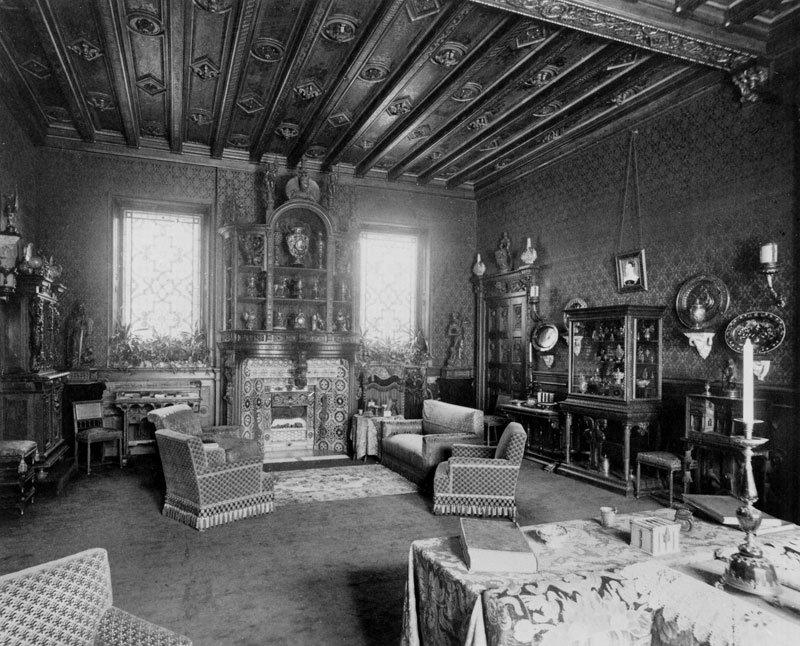
Ferdinand was not, of course, an entirely unusual example. He was only one among the redoubtable family of collectors that left the ‘Rothschild taste’ (le goût Rothschild) to posterity. Yet, Waddesdon Manor, besides the British Museum bequest, now represents the only intact example of the 45 Rothschild houses and collections created across Europe in the 19th century and it was very clearly with an eye to his legacy that Ferdinand left these treasures to the museum. He ensured they would remain together, cared for, and eternally tied to his name and cultural achievements. In the catalogue written to accompany the first public display of the Bequest, the Keeper of the Department of British and Medieval Antiquities, Sir Hercules Read, in fact argued that ‘the separation of bequests or individual collections is…contrary to the principles that should govern all museums’ and went on to discuss the understanding of fashion that could be gleaned from separate collections. That of Ferdinand certainly expresses a unique, and yet very ‘period’ taste that reflects rekindled European interest in the artistic successes of the Renaissance during the mid 19th century.
An obvious point of comparison might be the Gilbert Collection. When Sir Arthur Gilbert (1913–2001) gave his exceptional group of decorative art objects to the British nation almost a century later in 1996, it was one of the largest gifts ever to have been made by a private collector into public ownership. It was donated as a discrete collection, not to an existing institution, but following the offer to display it in a permanent exhibition in specially created galleries in Somerset House, which opened in 2000 (the collection relocated to the V&A in 2008). Gilbert’s gift had originally been intended for LACMA (Los Angeles having long been his adopted home), but was redirected after disagreements with the curators over its display and space allocation. It was, significantly, Jacob Rothschild, fourth Baron Rothschild, who masterminded the gift. The Chairman of the Rothschild Foundation, which leases Waddesdon Manor from the National Trust and has funded the redisplay of the Waddesdon Bequest, Lord Rothschild was then also Chairman of the National Heritage Memorial Fund, which paid for the restoration of Somerset House. Lord Rothschild clearly came to the project with a strong sense of the prospective legacy of a personal collection.
Gilbert’s decision to transfer the gift to Britain was explained as wishing to leave his mark in his native land, but was also dependent on Gilbert himself maintaining control of the display. This led to some unusual choices, with Gilbert shipping the entire contents of his Beverly Hills office over as a centrepiece of the new galleries, complete with a waxwork of the collector permanently fixed at his desk. This feels like the ultimate statement of the type of posthumous demand made by collectors such as Ferdinand de Rothschild and Arthur Gilbert, where the collector to some degree becomes curator, not only in their careful display of objects in their own home, but also when that collection becomes public. Both men stated a clear commitment to the idea that their modern wealth provided a bridging point across which artistic treasures could pass from Europe’s historic aristocratic collections into the public realm. Gilbert saw his collection as a means of creating a permanent legacy for the achievements embodied in a modern fortune. Ferdinand saw himself as facilitating the flow of objects from private hands into public ownership. Yet, both also clearly sought to impose their personality permanently on the resulting displays, not only through their object selections, but also through how the distinctive identity of those pieces as a group had been formed through their own.
Ferdinand’s careful amassing of his objects has often been seen as a major inspiration for Henry James’s novel The Spoils of Poynton (1897), with Waddesdon as the model for the richly furnished house of Mrs Gereth. But this takes us to the other side of the coin, to the shaping of a collector by the personality of his or her objects; to the power of their identity over his, rather than his over theirs. For Mrs Gereth is ultimately destroyed by her collection, passionately attached to her objects to the detriment of all personal relationships. Ferdinand was undeniably in thrall to his objects, and it is indicative that he is now known almost exclusively for his collections and their arrangements at Waddesdon and the British Museum, rather than his political and municipal efforts as a British subject. In Buckinghamshire, he was a Justice of the Peace, County Councillor, High Sheriff, and eventually MP. He founded a children’s hospital in Southwark in memory of his wife, and he worked tirelessly for the Jewish community of London. Yet it is in his collections that Ferdinand is remembered: in his exquisite Holy Thorn Reliquary, Deblín Cup, Horace Walpole’s maiolica vases, the Grenville jewel, and the ‘Cellini bell’. Significantly, many of these are named objects themselves, forever associated with their previous owners.
Walter Benjamin (1892–1940) recognised this entwined relationship between collector and objects when unpacking his library in 1931. In a celebrated lecture examining his own bond with his books, he observed that ‘ownership is the most intimate relationship that [man] can have to objects. Not that they come alive in him; it is he who lives in them.’ Each book represented a particular memory or relationship, each rearrangement a new statement of identity and purpose. He argued, further, that this was the essence of the act of collecting itself: ‘the phenomenon of collecting loses its meaning as it loses its personal owner…Only in extinction is the collector comprehended.’ It was particularly in contrast to the more ‘socially acceptable’ and ‘academically useful’ creation of public collections that he made this claim. It is only in the amassing of objects that the collector’s own life is constructed and lived, says Benjamin, and only in the act of passing their collection to a public institution that this becomes visible.
It is very clearly the voice of a collector that comes through here. Benjamin writes not only as a philosopher and cultural critic, but also as a lover of books, a careful pursuer of rare and beautiful editions, steeped in the thrill of acquisition and classification. The politics, economics, sociology, psychology and sheer fascination of collecting have spawned writings from scholars in every discipline, but there is something particularly personal that shines through in the writing of those who themselves collect, a sense of identity held elsewhere. One other such writer and collector was Sigmund Freud (1856–1939). His office at the Freud Museum in Hampstead encompasses a different world to the rest of the house, carefully maintained after his death by his daughter Anna and now the curators. Separated from the rooms of solid, bourgeois furniture, the study is home to Freud’s mind, his theories, books and crucial discussions with patients on the legendary consulting couch. It is also home to his important collection of over 3,000 ancient artefacts.
Freud theorised his collecting as stemming from the death of his father, as a male expression of identity and vitality. It was the means of keeping his own death at arm’s length, of continuing to live by constantly adding to his objects: ‘a collection to which there are no new additions is really dead’. Comparable to Ferdinand’s mode of sociability, this included the gifting of objects to friends and relatives, or exchanging them for different pieces. The collection had life through its relationship to other people and objects and this, in turn, shaped his own identity. Freud also, of course, collected his patient’s cases, memories, dreams and ‘parapraxes’ (slips of the tongue, mistakes, mislayings, failures of action). His professional practice and legacy as a theorist was based on the careful amassing of unique pieces, their arranging and interpreting within a discursive space. His deep interest in the individuality of each of his artefacts is directly comparable to the relationships he developed with patients.
Sigmund Freud’s (1856–1939) study at his Hampstead home, including some of his collection of over 3,000 ancient artefacts. Image: courtesy The Freud Museum, London
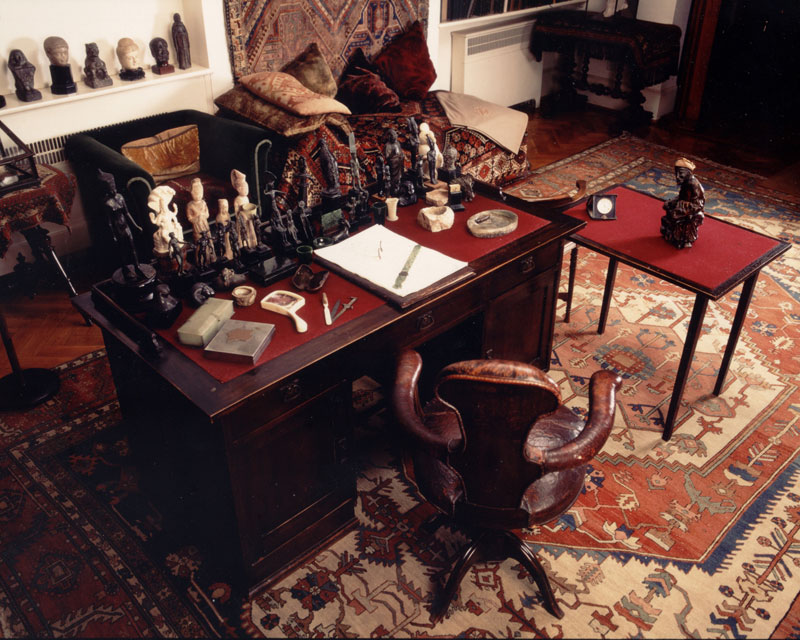
If anything, Freud was more honest than his fellow collectors in his search for immortality, in constantly avoiding adding that final object to the collection that would render it complete, but therefore also somehow dead, and its owner with it. In museums, we often see objects as going through a form of death on entering the collection: being taken out of circulation, of their historical or geographical frame of reference, of the market. But from Freud’s perspective it was in this removal that objects, and therefore their owners lived, in the creation of a space where concerns other than money framed the collection, where ideas lived. It is, then, in this space removed from the market that collections like Ferdinand’s find their true wealth, in the legacy of a personal collector within a public institution: as curator and maker, but also as curated and made themselves.
The Waddesdon Bequest will be redisplayed in a new gallery at the British Museum that opens on 11 June.
Click here to buy the latest issue of Apollo
Related Articles
How should private collectors and public museums work together? The TEFAF Symposium 2015
Private Views: how do you open a private collection up to the public?
Ten house museums to visit this year
‘Houses as Museums…Museums as Houses’, conference at the Wallace Collection
